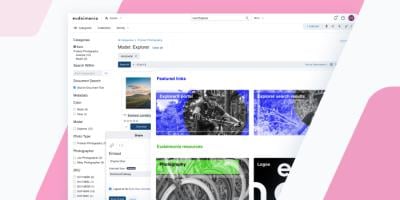
A Guide to Repurposing Content With Digital Asset Management

When a t-shirt is no longer wearable, is your instinct to throw it away or to turn it into a dust cloth? When you cook bacon, do you toss the grease or save it for your favorite chili recipe? Repurposing is a smart and effective way to get more use out of your resources while preventing waste.
More and more organizations are reaping the benefits of content repurposing. For example, a graphic for a slide deck can be repurposed for a social media post. A clip from one video can become b-roll for another. This savvy approach to content creation and repurposing not only helps your team extract more value from content but also supports a consistent message and brand style across multiple channels and campaigns.
A digital asset management (DAM) system plays a crucial role in an organization’s ability to reuse and repurpose content. A DAM system facilitates secure storage, searchable metadata, file conversions, and easy sharing for your digital assets, whether those assets are final content deliverables or individual pieces.
What is content repurposing?
Repurposing content refers to adapting existing copy, imagery, video, or other creative content for another use. And it’s important to understand that repurposing content is not the same as reusing — it’s the ability to reimagine content to serve new purposes. When something is reused it is simply used for the same reason, in the same way, multiple times. But when something is repurposed, it is altered and/or incorporated into other forms without being completely recreated.
In terms of digital assets, repurposing is all about adapting images, videos, and other media for use in different channels, promotions, and campaigns; instead of creating one asset for a brochure and a very similar, separate one for a website.
In today's multi-channel marketing environment, repurposing needs to be part of any successful content strategy.
How to repurpose content
Repurposing is guided by a need, and the resources to satisfy that need. For example, while cleaning out your closet you might wonder what to do with an old, cozy sweater...and then transform it into a pair of mittens. Other times a need might inspire you to create a solution...like a walk in cold weather might make you think about how nice it would be to have your hands in an old, cozy sweater!
Repurposing content is guided by the same concepts. Sometimes you’ll ask, “what are other ways can we use this great content?” Other times the question will be, “what existing content do we have to fill this need?” Either way, the following steps will help you become a repurposing content expert.
Keep your digital assets organized
An organized asset library is critical to effective content repurposing. Your content creators and designers need to know what’s available and where it is in order to use and reuse it.
A good storage system, like a DAM platform, should provide two ways to find assets. The first is browsing categories of assets, which is helpful when you’re looking for inspiration or have a general idea of what you want but don’t have a specific asset in mind. For example, you may want to browse an in-house photo library for an image of someone riding a bike.
The second method is searching and filtering by metadata to find specific assets, which is the best approach when you know what you are looking for. For example, if you need to feature a product image in a marketing brochure, you would likely search by product ID or product name.
Consider incorporating asset storage and organization as part of your team's definition of done for content projects. Perhaps the last step of a project is to upload it to the DAM system with the proper file naming convention and apply relevant metadata.
Think audience first
Think audience first to keep your content use and reuse focused on who the content is for, what they’ll get out of it, and what that means for your business. You don’t want to adapt a piece of content for another channel or format just because you can.
Repurposing content is most effective when you have a goal in mind and you know what assets you have available to support it. Your goal might be to reach a new audience, extend into a new channel, or support a different vertical. Understanding what content you have on hand and how to easily find it will make the process of repurposing for a specific audience much more feasible.
Select the right digital assets for the project
Remember our sweater mittens example? Using an old t-shirt wouldn’t do the job. The old sweater provides the warmth that mittens require. Similarly, you need to think about the qualities of your content that will make it effective for the project.
If you’d like to include a graphic illustrating the benefits of your product in a sales brochure that’s on your website, you need to have access to the design file. You can’t just copy and paste a small JPG file into the brochure because it will look distorted.
If you’re using a DAM system, upload the original file and set up file conversions so that other teams can download the format they need. Including all of the elements of a piece in the DAM platform, either packaged in a zip file or as individual assets tied together with metadata, will allow the designer to easily locate the specific graphic file they’re looking for instead of having it locked in the final PDF version.
Update and share the content
Once you have the individual pieces to repurpose content, it’s time to put it all together. As your content takes a new form, make sure that it has a consistent look and natural flow. Be sure to use the same attention to detail you would in the creation of new content. Once you’ve reviewed your work, it’s time to share and promote it to your audience.
Benefits of repurposing your content
Repurposing your content leads to more effective and efficient content efforts.
- Maximize content ROI: Gain a better return on your content investment by adapting it for multiple use cases.
- Improve brand consistency: Build brand consistency and recognition by repurposing assets across multiple channels.
- Reduce waste: Reduce the amount of time your teams spend creating redundant or similar content.
- Create content faster: Meet the demands for more content faster, by incorporating relevant, existing assets.
- Democratize content publishing: By providing assets to be used and repurposed, more teams can publish on-brand content.
The pliable nature of digital assets, combined with modern multi-channel marketing, makes repurposing a must for every business. It can take some time to shift thinking from constantly creating completely new content to using resources more effectively...but it’s worth it.
Explore how DAM can help tackle the challenges of misplaced and misused digital assets. Request, watch, or click through a demo of our solution, Acquia DAM (Widen) to see brand management in action.
Note: This article was originally published on Widen.com



